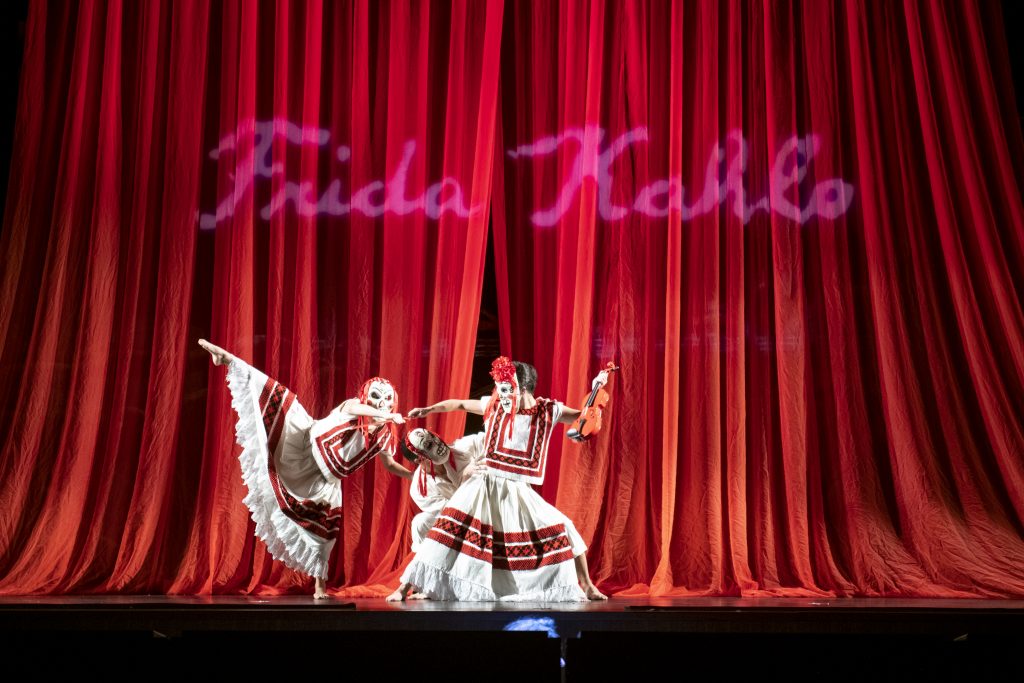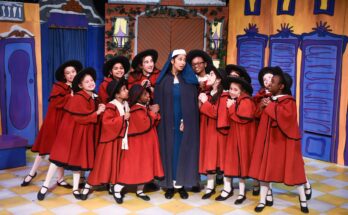Story by Noel Morris
Photos by Rafterman Photography
Fierce. Wounded. Spellbinding. Frida Kahlo lived life like a work of art. With almost unnatural zeal she pursued her greatest passions: self-expression, Mexico, feminism, social justice, and love.
Now fixed into the fabric of popular culture, her paintings bear witness to her anguish. Beguiling as they are unsettling, her self-portraits ensnare the viewer in an accusing and uncompromising gaze. At the same time, they provide unvarnished testimony to major events in her life, flowing seamlessly into the 1991 opera Frida by Robert Xavier Rodríguez.
A NOTE FROM THE COMPOSER

“The music of Frida is in the Gershwin- Sondheim-Weill tradition of exploring the common ground between opera and music theater. The score calls for mariachi-style orchestration—with prominent parts for accordion, guitar, violin, and trumpet—in which authentic Mexican folk songs and dances are interwoven with bits of tangos, colorations of zarzuela, ragtime, and jazz. Among the ‘stolen’ musical fragments developed in Frida are such strange musical bedfellows as two traditional Mexican piñata songs (“Hora y fuego” and “Al quebrar la piñata”), two narrative ballads (“La Maquinita” and “Jesusita”), the Communist anthem (“L’Internationale”), Tchaikovsky’s Fourth Symphony [to accompany the entrance of Russian dissident Leon Trotsky], and Wagner’s Tristan and Isolde [to accompany Kahlo’s confrontation miscarriage. with Henry Ford]. Spanish speakers might also listen for the rhythm of a LOVE familiar Mexican curse growling in the trombone as Lupe (Diego’s former wife) insults Frida and Diego at their wedding.
PAIN

On September 25, 1925, 18-year-old Frida Kahlo suffered devastating injuries when the bus she was riding collided with a streetcar. She sustained fractures to her spine, collarbone, and ribs. Her pelvis was shattered, her shoulder dislocated. Her right leg sustained eleven fractures, and her foot was crushed. An iron rail pierced her abdomen and uterus. From that point on, her life was an unending succession of surgeries, including the amputation of her right leg below the knee in 1953. Some researchers believe that Kahlo was born with spina bifida, a neural tube defect affecting the spine and spinal cord. In later years, she became addicted to painkillers.
Already, the teenaged Kahlo had had an uneven gait: Her right leg was withered due to a childhood bout with polio. As an adult, Kahlo longed to bring a little “Dieguito” into the world (a reference to her husband Diego Rivera). Because of complications from the accident, more than one pregnancy ended in abortion or miscarriage.
LOVE

“There have been two great accidents in my life. One was the trolley, and the other was Diego. Diego was by far the worst.”
Kahlo was 21 in 1928 when she met the great Mexican muralist Diego Rivera. Twenty years his junior, she became his third wife in 1929. Rivera’s persistent philandering put a tremendous strain on their marriage. Eventually, Kahlo took lovers of her own, including the famed Marxist Leon Trotsky (an affair which infuriated Rivera). Unconfirmed rumors suggest she also had liaisons with Josephine Baker and Georgia O’Keeffe. Nevertheless, when Rivera slept with Cristina Kahlo, Frida’s sister, the shock was unbearable. The couple divorced in 1939. They remarried in 1940 and kept a volatile union until her death in 1954.
SELF-EXPRESSION
Frida Kahlo detested the conventional female identity. Instead, she put enormous care into cultivating a personal brand. Starting as a teenager, she embraced what she referred to as her masculine features and sometimes donned a man’s suit. Fastidious in her makeup, she favored bold lipstick colors while applying an ebony eye pencil to emphasize the iconic unibrow. Spurning the day’s fashions, she favored the traditional Mexican Tehuana costume with braided hair, heavy jewelry, floral headpieces, and a faint mustache—all of which leapt into her 55 self-portraits. Documenting the surgeries, her marriage, the body cast, the brace, and her failed pregnancies, Frida Kahlo wrote the story of her life into her canvasses.
POLITICS
With her customary flare for drama, Frida Kahlo liked to declare that she was born in the year of the Mexican Revolution, the conflict which led to the ouster of the ruling elite. In truth she was three years old at the outbreak in 1910. Throughout her life, she remained an ardent proponent of Mexican pride. Often, her politics were (and are) conflated with that of her husband, Diego Rivera, who was a Communist activist. While Kahlo was perhaps less interested in expounding upon political theory, she despised pretense and materialism, which she associated with American industrialists. She was outraged by their disregard for the poor and the working people.

In 1937, Rivera persuaded the leftist government of President Lázaro Cárdenas to grant asylum to the exiled Communist Leon Trotsky. Rivera welcomed the Russian exile into the Kahlo family home, La Casa Azul. When Trotsky had an affair with Kahlo, Rivera (himself an unapologetic womanizer) threw him out on the street. Trotsky was assassinated in Mexico City in 1940.
With her customary flare for drama, Frida Kahlo liked to declare that she was born in the year of the Mexican Revolution, the conflict which led to the ouster of the ruling elite. In truth she was three years old at the outbreak in 1910. Throughout her life, she remained an ardent proponent of Mexican pride. Often, her politics were (and are) conflated with that of her husband, Diego Rivera, who was a Communist activist. While Kahlo was perhaps less interested in expounding upon political theory, she despised pretense and materialism, which she associated with American industrialists. She was outraged by their disregard for the poor and the working people.



